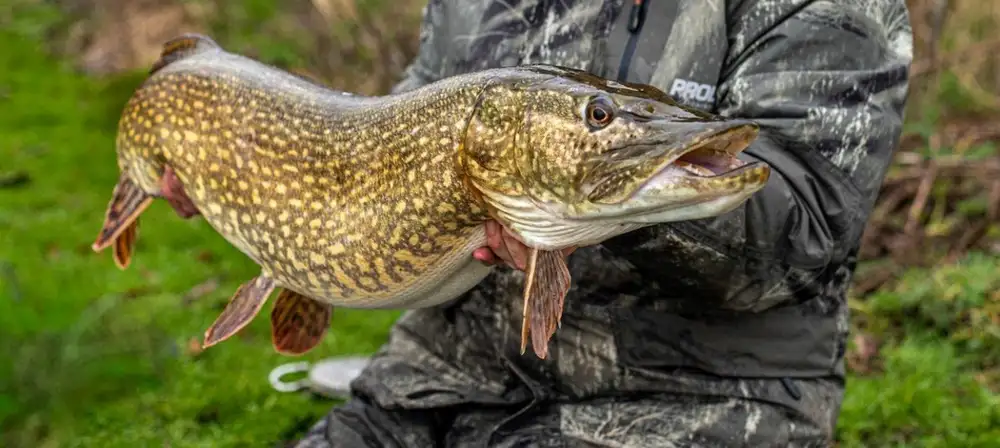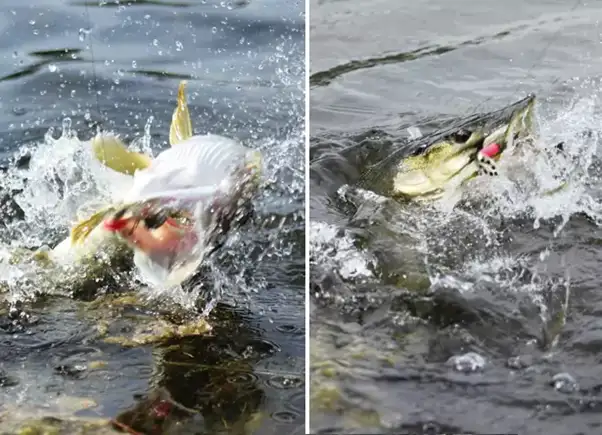This is a demo store. No orders will be fulfilled.
Your Guide to Catching More Pike on Lures - with Mick Brown

Pike season is certainly amongst us. Plenty of predator anglers are excited for the temperature drops to get in on the heart-pounding action of catching a pike but if you are a novice seeking from useful tips and advice, we here at Angling Direct can certainly provide.
This guide offers advice from top predator hunter Mick Brown, sharing exactly how to catch more pike on lures. Predator lure fishing offers an exhilarating experience, changing it up from the calm, occasional twitching of your rod tip on your local commercial.
What kind of fish is a pike?
One of the world’s finest freshwater predators, the pike or Esox lucius has a distinct and fierce appearance including;
-
A large bony head with prominent eyes
-
A broad flat snout
-
A very large, often sharp mouth
-
The top jaw of a pike has razor-sharp teeth
-
The bottom jaw has needle-like teeth
-
A pikes body is a long, torpedo shape
-
Olive and cream colouration
-
It’s fins are positioned at the rear
-
Marking patterns are unique to each pike

How to catch a Pike in the UK:
When pike are in the mood they will attack lures with gusto, giving you a proper slamming bend in your rod and a very big grin on your face, however, that doesn’t mean it’s easy. Get predator lure fishing wrong and you could be in for some long, fishless days! Luckily, we have top tips from predator legend Mick Brown to hand so we can talk through a professional’s approach to catching more pike on lures.
Predators have an equation in their feeding. They need to consume more energy than used to catch prey. Big baits (more energy) should be more attractive than little baits and the easier they are to consume (deadbaits don’t need chasing) the less energy the predator uses.
1) Locating the Pike
Before you go breaking out the lure box to check out your own collection, there is plenty of factors to consider when it comes to Pike fishing that will, in turn, help narrow your lure choice and improve your success rate.
Mick says, “you can cast any lure you like but if they’re not where you’re fishing, you’ll catch nothing.” So let's consider how to find pike in UK waters.
- Wind Direction: Paying attention to the wind direction plays a huge part in fish locating. As Mick tell us “the wind will move natural food into this bay and the small fish will follow that,” these small fish will then create an attractive food source for pike.
- Water temperatures: Mick explains “When it’s warm pike will have more energy and will move up quite a way in the water to hit prey, but in the depths of winter they are less likely to move far so you have to really work out where they’re sitting and get as close to them as you can.”
- Feeding Depth: Once you pinned the likely area the pike will be in, the next key thing to figure out is the depth that they’ll be feeding at. Most pike will lie on the bottom, however, it is good practice to run through the lures that will give you various depths at the start of a session to see if you can work out where the pike are striking.
- Knowledge of the venue: It helps to be familiar with the water you are fishing at as it makes identifying feeding depths easier and quicker.
- Time of Year: In spring and autumn Mick starts at the surface with his lure and works his way down. In the winter he starts with lures worked right at the bottom and move up until it gets hits.

2) Choosing your Lure
Once you have worked out where the pike are and at what depth they’re feeding; now you need to figure out what will make them strike the most effectively. With so many choices of fishing lures on offer it can be hard to know which one is right for the job. Start with the basics and figure out the type of lure you want to fish with. The key is to keep trying out variations until you find one that attracts the pike. Mike favours hard lures from tops fishing brands such as Storm, Rapala and Fox.
Mick’s Lure Choices
- Surface Lures: Work better in spring and autumn when pike will hit on the surface, but they’ll still work in winter on shallow waters.
- Floating Plugs: Sit on the surface and can be cranked down to a specific depth before they rise back up – great to work over weed.
- Suspending Divers: These lures will slowly sink or suspend at a specific depth if left, but will also dive when retrieved. Great for slow retrieves.
- Slow Sinkers: Good to count down to a specific depth and get right to the bottom if needed before working, as they will sink down from the surface.
- Metal Spoons & Spinners: Although old school, spoons and spinners are still hugely effective pike catchers. They can be worked at any level in the water with a varied speed of retrieve – don’t leave home without them.

Mick Brown and Matt Hayes have a section on AD’s website that covers kits perfect for Pike Fishing. Click here to check it out!
3) Best Lure Retrieve and Behaviour for Pike Fishing
Lure Speed: The cooler the temperature, the slower the lure. In winter, pike want an easy target so slow your retrieve right down to a snail’s pace. For autumn pike fishing or spring, aim for a fast retrieve rather than slow to trigger the pike’s predator instincts.
Lure Pattern: Mick advises choosing a lure that looks similar to what pike in your chosen venue are used to feeding on. Mick personally goes for lures that are a similar shape, size and colour to roach and rudd. Occasionally, pike are attracted to change and a brightly coloured lure will instantly spark a pike to bite.
Lure Size: Mick suggests for pike fishing, to start with lures sized 12 centimetres. This is a middle-of-the-road size and great for all sizes of pike. If you go bigger, though, you’ll focus on the bigger pike, and if you go smaller you could pick up other species such as perch and zander.
Lure Action: When picking your lure, consider the clarity of the water you are fishing. If you are fishing murky waters where the colour, size and overall look of the lure is not going to benefit you, be sure to select a lure that boasts lots of vibration and noise like a spinner.

4) Selecting the Best Predator Rod and Reel
You may take with you on your fishing session, a variety of lures and sizes, therefore requiring a couple of different rod and reel set-ups. Mick explains that the “casting weight and rod action make a big difference, especially when you want to put action into a lure, so I have two different weight setups.”
You can cover a lot of lures with two rods. Choose one lighter and paired with a baitrunner reel loaded with 20lbs braid and the other being a heavier option. For anglers using bigger lures on a pike session, always opt for heavier setup, with a 20-50g rod and a Spin 4000 reel loaded with 30lbs line.
Mick explains for beginner pike anglers that “you don’t have to buy a new reel especially for lure fishing straight away, you can give it a go with the one you use for float or feeder fishing.” Try lure fishing with a float or feeder styled reel in 2500 to 4000 sizes and load with braid.

5) Pack your Predator Fishing Tools
The most important items for any pike angler to carry are unhooking tools and equipment.
- Fishing Pliers: Those sharp teeth and treble hooks mean that pliers are a must! Mick rates fishing pliers over forceps as they’re stronger and often offer better grip.
- Bolt Croppers: These are ideal for cutting through trebles that are stuck in the fish’s mouth.
- Unhooking Mat: Pack your unhooking mat or cradle as pike need just as much careful fish care as our beloved carp. Check out the huge range of Advanta unhooking mats.
If you’re a bit unsure about landing and unhooking a pike it’s always a good idea to go with someone with a bit of experience to show you the ropes until you can do it yourself.
This post was originally posted in ...

For more tips and tricks, check out our guides on the AD blog or video tutorials over on ADTV. For Mick Brown fans, check out the video below for his pike fishing session with Matt Hayes and the AD Team.
For updates and more great fishing content, follow us on our social media pages!


